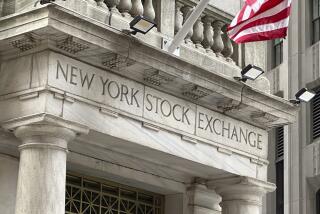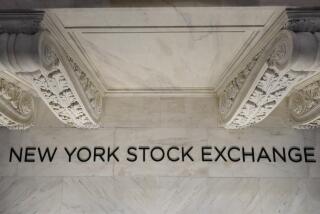Foreign Markets Lag, With Some Hot Spots
U.S. investors who reaped huge gains in foreign stock markets last year had to settle for a lot less in the first quarter of 2000.
Still, many markets performed well--often because they were stoked by the same heated demand for technology issues that powered the U.S. Nasdaq market.
But just as in 1999, the dollar’s strength hurt the returns that Americans brought home from overseas, especially in the case of European markets.
Diversified foreign stock mutual funds generated a 1.9% total return, on average, in the quarter, according to Morningstar Inc. That lagged the 6.8% average return of domestic stock funds.
But depending on the parts of the world in which your foreign fund was most heavily invested--and whether it focused on technology issues--your returns could have been much better.
Hedging by fund managers against currency movements also might have helped, or hurt.
The average Europe-only stock fund gained 7.9% in the quarter, even though the dollar’s strength bit into results.
The tech-heavy Payden & Rygel European Aggressive Growth Fund, by contrast, shot up 36.9% in the quarter.
The average emerging markets fund was up 3.7%. But Eaton Vance Greater China fund rose 17.9%, fueled in part by some streaking Chinese and Taiwanese tech issues.
Among the best markets overall in the quarter in terms of gains measured in the local currency were Taiwan, where the main market index rose 19%; Canada, up 12.5% on the strength of telecom and other tech stocks; and Germany, up 9% as shares such as Epcos, a maker of computer chips, led the way.
A pullback late in the quarter clipped the Mexican and Brazilian markets, where the key indexes rose 4.8% and 4.3%, respectively, for the three months.
But in those countries the native currencies strengthened against the dollar during the quarter. The result: Gains achieved in those markets were worth even more when translated into dollars.
In dollar terms, the Mexican market rose 7.7% and the Brazilian market added 8.1%.
Among the worst-performing markets in the quarter were several smaller Asian markets. The Thai market, for example, tumbled 16.9% in native currency terms as profit-takers moved in after last year’s rise.
The South Korean market also suffered, losing 16.3% in native currency terms.
In Japan, meanwhile, the Nikkei-225 blue-chip index gained 7.4% in the quarter, reaching its highest level since mid-1997 despite widespread fears that the economy might slump anew.
On Monday the latest business confidence survey issued by the Bank of Japan indicated that corporate sentiment was continuing to improve.
That shows in the strengthening yen: Although the yen’s value weakened to 112 per dollar by late February from 102 at year-end, by late last week the yen was back to where it began the year.
But a stronger yen brings new worries. Japanese authorities fear that rapid strengthening of the yen may derail the economy’s recovery by making exports more expensive and by eroding the returns on overseas securities bought by Japanese investors.
There’s no such currency concern in Europe, where the euro currency remains the world’s 90-pound currency weakling.
The euro ended the quarter at 95.5 U.S. cents, down from $1 at the end of 1999. Despite strong growth in many euro economies, and despite rising interest rates courtesy of the European Central Bank, the euro’s value can’t seem to get a lift.
But for many European exporters--and the foreign investors who own them--that’s just fine: A weaker euro means European exports are cheaper for U.S. buyers.
As the second quarter gets underway, the key to the performance of many foreign markets is the same as for the U.S. market: the direction of technology stocks.
The decline in tech stocks worldwide in recent weeks is prompting some money managers to seek bargains in the sector.
“On the way up, markets weren’t distinguishing between winners and losers, and it’s the same on the way down,” said Jeremy Podger, European fund manager at Investec Guiness Flight, which oversees about $20 billion. “There are lots of chances to buy relatively cheap shares as the sector falls.”
The Bloomberg European Internet index dropped 5% last week and 19% in March, amid concern increased competition and more new stock issuance will reduce the value of established European online companies.
Moreover, Templeton mutual funds’ emerging-markets guru, Mark Mobius, spooked investors last week by warning that he believes a global Internet stock crash in likely this year.
“If you need to hold shares in these industries at the moment, pick the leaders in each market and avoid the third- or fourth-string companies because they’re getting hit the hardest,” said Adrian Darley, who helps manage $8.8 billion in European equities at Gartmore Capital Management.
Kim Hae Dong, a fund manager at Hanwha Investment Trust Management Co. in Seoul, said he plans to buy more shares of beaten-down Samsung Electronics. “Memory chip prices are bound to jump beginning the second quarter of this year as demand slowly outweighs supply,” Kim said.
But the trend in foreign tech stock prices may well depend on whether U.S. investors jump back into their own leading tech issues, or begin dumping them anew.
“The Nasdaq today is the compass for the Brazilian market,” said Eduardo Favrin, who manages $285 million in equities at Chase Asset Management in Sao Paulo.
The link between Nasdaq and the two biggest Latin American markets, Brazil and Mexico, has grown tighter in recent months, as the three markets have tracked each other’s ups and downs.
Yet while lambasting Internet stocks, Templeton’s Mobius defended investing in Latin American telecommunications stocks, which dominate Latin markets.
In Mexico, the main Internet play is Telmex. Mobius listed Telmex as one of his favorite picks.
But if Nasdaq continues to dive, “it’s not going to be pretty for Latin America,” said Renato Grandmont, chief Latin America strategist at Deutsche Bank in New York. “If the bull market is over, it’s over also for the Dow and a lot of other indices.”
(BEGIN TEXT OF INFOBOX / INFOGRAPHIC)
A Mixed Quarter Overseas
Stock markets around the globe were mixed in the first quarter, in marked contrast to the generally stunning gains across the board in 1999. Profit taking slammed some smaller Asian markets. Meanwhile, solid gains in such markets as Germany and France were offset by the strong dollar, slashing returns for U.S. investors.
*
*--*
1st qtr. price change: 1999 change Market/index Actual* in dollars in dollars Taiwan/weighted +19.0% +22.7% +35.0% Canada/TSE-300 +12.5 +12.3 +38.0 China/Shanghai B +10.4 +10.4 +32.0 Germany/DAX +9.0 +3.5 +20.3 Japan/Nikkei-225 +7.4 +7.1 +52.0 France/CAC +5.5 +0.2 +30.8 Mexico/IPC +4.8 +7.7 +87.5 Brazil/Bovespa +4.3 +8.1 +69.2 Hong Kong/Hang Seng +2.6 +2.5 +68.2 Australia/All Ord. -0.6 -8.1 +20.6 Netherlands/AEX -1.4 -6.3 +7.9 Britain/FTSE-100 -5.6 -7.2 +14.9 Singapore/S. Times -14.0 -16.3 +76.3 S. Korea/composite -16.3 -14.5 +93.0 Thailand/SET -16.9 -17.7 +32.4 U.S./S&P; 500 +2.0 +2.0 +19.5 U.S./Nasdaq composite +12.4 +12.4 +85.6
*--*
*
* in native currency
Source: Bloomberg News
More to Read
Inside the business of entertainment
The Wide Shot brings you news, analysis and insights on everything from streaming wars to production — and what it all means for the future.
You may occasionally receive promotional content from the Los Angeles Times.










